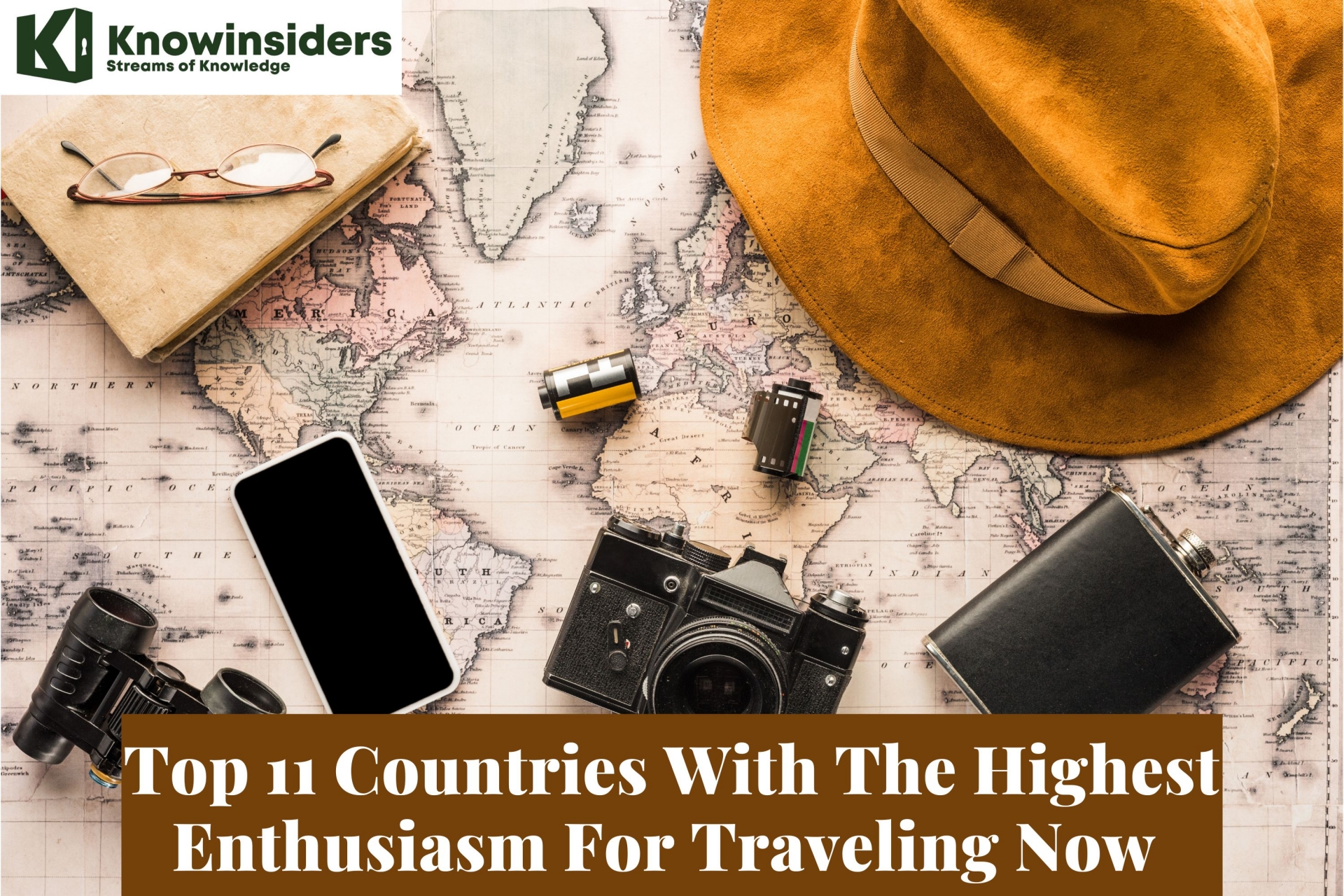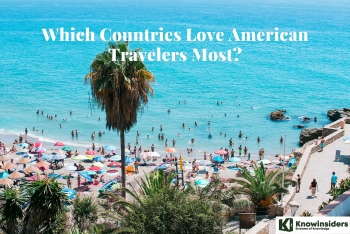Top 11 Countries With The Highest Enthusiasm For Traveling Now
 |
| Top 11 Countries With The Highest Enthusiasm For Traveling Now |
| Table of Content |
Booking.com has launched its inaugural APAC Travel Confidence Index, which provides a snapshot of how confident consumers feel about exploring the world again, as well as whether they would welcome inbound travel. The commissioned research polled 11,000 travelers from 11 countries and territories¹ across Asia and Oceania between April and May 2022, combining this with the company’s proprietary data and insights as a digital travel leader over the past 25 years..
According to a Booking.com report, 81% of global travelers confirm that sustainable tourism is important to them, with 50% saying that the latest news on climate change has affected their sustainable tourism options.
In the APAC region, many people want to travel just to escape the pressure of work. In Southeast Asia, people pay high attention to mental health, with 56 percent of those surveyed considering this the most important reason for them to travel.
Traveller Confidence Is High: Overview
Speaking at the event organized in tandem with World Environment Day, Laura Houldsworth, managing director, APAC, shared the findings of the study which polled 11,000 travelers across 11 countries and territories and looked at comfort levels, and motivators, and concerns of consumers.
Indian travelers are leading the way for Southeast Asia for confidence. “They are raring to go,” said Houldsworth. Incidentally, Jeannie Lim, assistant chief executive, policy, of Singapore Tourism Board, speaking at the same event, noted that India is also the number one incoming source of travelers to Singapore.
Following in confidence are Vietnam and China. The research indicates that Indian, Vietnamese, and Chinese respondents were most willing to put up with and/or overlook key travel deterrents in order to travel – which included enduring disruptions and travel costs; as well as confidence in their home countries/territories in receiving inbound travelers. Conversely, a majority of Japanese respondents (75%) expressed uncertainty about border reopenings, as well as their country’s preparedness to safely receive international travelers (82%).
Rather surprisingly, Singapore ranked 6th on the Travel Confidence Index despite having some of the most eased border restrictions in comparison to many markets across the region. Key factors that impacted Singapore’s standing in the index included general aversion towards any disruptions to their travel (65%) alongside that of sharing personal information for public health and safety (57%) and personalization (45%) – a key element in most countries’ COVID-19 management strategies.
A look at the costs
By their very nature, the revenues and expenditures per tourist can only reflect what is statistically ascertainable. If a vacationer travels across Europe in a motor home and always pays cash in Euros, these expenses can hardly be measured.Such a traveler is not registered anywhere and the expenses can also only be attributed to a country of origin if credit card payments or cash withdrawals permit.
Travel expenses also include transfer prices, such as for flights. However, this only applies to flights whose airlines are also based in the destination country. Countries with many of their own airlines and good international connections therefore generate higher revenues than smaller countries. The fact that Bulgaria, for example, only earns $360 per traveler is also due to the fact that the country, with only one airline of its own and relatively small, does not generate significant passenger numbers. If a foreigner lands in Sofia with any non-Bulgarian airline, the airfare does not count as tourist income. If instead a traveler lands with Air France in France, Thai Air in Thailand or American Airlines in the USA, the air ticket counts. Additionally in many European countries, revenues are lower simply because travel is often by car or train.
Importance Of Responsible Traveling In Present Time
The importance and benefits of traveling are tourists get to know about the culture of different lands, easy to make friends en route travel, one learns about several other cultures and their needs, all the while undertaking adventures, praising the natural beauty, and much more. The ecological footprint also has an impact on travelling or in other words, one should take a responsible travel as it will help in involving with other communities, restoring of natural environment, the materials that are harmful to environment should not be dumped at natural sites, reductions in carbon footprints, and working towards social or financial goals.
Full List Countries With The Highest Enthusiasm For Traveling Now
1. India
 |
| Photo: whoatravel |
As the world starts to emerge from strict border closures, Indians are eager to make their travel dreams a reality in the next few months. 86 percent of Indian travellers stated that they intend to travel in the next 12 months. And despite some COVID-19 restrictions, travel optimism continues to remain high with 70 percent of Indian travellers accepting of anticipated travel disruptions and 78 percent considering leisure travel as important while keeping their overall health and safety in mind.
While corporate travel is beginning to make a comeback, the shift to remote working and virtual meetings has perhaps brought about a shift in the way we work. Despite many employees having returned to the office across India, only 25 percent of Indian travellers (average of 13 percent in APAC) indicated that work was a reason for them to book a trip. This signifies a slower revitalisation in corporate vs leisure travel.
2. Vietnam
Most Vietnamese tourists plan to book 1-2 trips this year (62%). 45% of people surveyed said they want to go to famous places near Vietnam (from 3 to 8 hours of flight), instead of short trips (less than 3 hours of flight) or long hours (more than 8 hours of flight).
Notably, up to 82% of people surveyed shared that they feel comfortable with Vietnam's reopening of the border, of which 75% are confident about the tourism industry's ability to welcome international visitors. .
The demand for relaxation and mental health care (55%) is the top motivation for Vietnamese tourists to travel in the context that tourism is recovering strongly after 2 years of closure due to the pandemic.
An interesting finding of the survey, up to 45% of Vietnamese tourists want to travel because they have planned before the pandemic but have not had the opportunity to do it, and now is the perfect time to hit the road. 32% of people surveyed want to travel to a particular place they love; Another 32% simply want to leave home, regardless of the destination.
The top concern of Vietnamese tourists is still cost, as indicated by 53% of the total number of people surveyed. Along with that, the difficulties caused by the pandemic will still create certain worries for many travelers, namely the “fear of being isolated” (36%) and the possibility of infection when traveling ( 32%).
3. China
Chinese tourists are among the world’s most maligned. But they also spend $300 billion abroad each year, making them a force too important to ignore.
Mainland Chinese citizens made 136.8 million trips across their borders (according to China Outbound Tourism Research Institute).
That’s roughly the same as the number of Americans (66 million) who travelled internationally in 2019. But here’s a difference: the Chinese are spending far more than anyone else.
Chinese tourists spent $292 billion (£224 billion) abroad in 2019, nearly three times as much as the second biggest spenders, the Americans, and nearly five times as much as Britons abroad. These are the most recent statistics available from the World Tourism Organisation, which has predicted a 14 per cent rise in Chinese spending in the future.
4. New Zealand
 |
| Photo: twowanderingsoles |
On average, New Zealanders make 4.3 total trips a year, the same as the Hongkongese. However, the ratios are in reverse. New Zealanders make less outbound trips (0.5) while the number of domestic trips is higher (3.8).
68% of New Zealanders plan to take a domestic holiday in the next 12 months — consistent with levels seen the same time a year ago.
Key triggers for taking a domestic holiday remain unchanged: needing a break, wanting to see more of New Zealand, visiting family or friends.
5. Australia
Everyone knows Australians love to travel, but a new study has found that we're not the biggest travellers in the world and that we still prefer domestic trips to international ones.
Australia was New Zealand’s largest international visitor market, accounting for almost half of all international visitor arrivals. 1.5m Australian visitors arrived Australian visitors spent $2.7b – an average of $2,044 per person
38% of Australian holiday visitors stayed between 8-14 days. 30% of Australian visitors arrived in summer and 22% in winter
6. Singapore
Singaporean travellers led the Asia Pacific region in terms of international travel as they fly more than four leisure trips compared to APAC’s average of 2.7 trips and the global average of 2.5 trips, a study by digital payments platform Visa revealed.
Despite more frequent travels by Singaporeans, the study to have shorter trips (around six nights per trip) compared to the APAC (seven nights) and global average (eight nights).
They also tend to fly to nearer destinations compared to APAC and global counterparts. In fact, Malaysia remains to be the most popular destination for Singaporeans as 47% of respondents said that they have visited the neighbouring country, as well as Japan (37%), and Thailand (36%) in the past two years.
7. Hong Kong
Hong Kong is the seventh most well-traveled country in the world. Although domestic tourism is almost non-existent (0.03), the average Hongkongese takes 4.3 outbound trips a year.
The citizens of Hong Kong were revealed to be the most seasoned travelers, taking an incredible 11.4 international tourist trips each year. And while technically not a country, Hong Kong operates much like a country separate from China (whose citizens only go on 0.06 trips per year). Its sky-high number of trips can be attributed to the region's 12 annual bank holidays, in addition to one rest day per seven work days that companies are legally required to give their employees.
8. Thailand
 |
| Photo: thislifeoftravel |
Thailand welcomed nearly 40 million foreign visitors last year, but Thais are increasingly being welcomed abroad as about 11 million Thais are expected to vacation overseas this year taking advantage of the stronger Thai currency.
Ten years ago, just 4 million Thais traveled overseas on vacation. In 2018, that number reached 10.2 million, according to the Ministry of Tourism and Sports. During the past five years, the number of Thais traveling overseas has risen between 7 percent and 8 percent every year.
Last year, neighboring Malaysia and Laos were the most popular destinations for Thais, but Japan was the most popular among countries not sharing a border with the Kingdom. The Land of the Rising Sun was followed by China and then several Eastern European countries.
9. Korea
More and more Koreans like to travel abroad. The GDP per capita is increasing (graph is below) so more Koreans want to enjoy their holiday abroad. On average, a Korean visitor to the U.S. spends approximately $4,900 per trip. In 2021, over 28.7 million Koreans, more than half of the population, traveled abroad (up 8% from the previous year).
Five of the most popular destinations among flight bookings & 6 destinations among hotel bookings are actually located in Southeast Asia. So many Koreans chose Southeast Asia for their summer vacation destinations.
10. Taiwan
The Taiwanese people began spending their vacations abroad after 1979. 470,000 people vacationed abroad during that first year. By 1988, the number was over a million, and it kept on climbing.
In comparison, though the Taiwanese loved to travel, they did so passively, often as a member of large tour groups. They were picky about what they ate and where they slept, but other than that a trip abroad was just a slideshow of scenic spots, with very few attempts to understand the local culture.
One of the reasons young ladies traveled abroad was to attend some concert or party in hopes of catching a glimpse of their favorite celebrities or to go shopping. Since younger people generally had fewer vacation days, Japan became their favorite destination: it was geographically close to Taiwan, culturally similar, and promised good dining and shopping.
On the other hand, retirees had more free time, not to mention a bucket list weighing on their minds. They preferred leisurely excursions on cruise liners or a long vacation somewhere far away with a trusted tour group. Every country visited was like a conquest, a checkmark on their list of lifelong dreams.
11. Japan
According to Japan National Tourism Organization (JNTO), the estimated number of international travelers to Japan in April 2022 was about 139,500, +1185.4% compared to the previous year, and -95.2% compared to April 2019.
It is the first time in two years and one month since March 2020 that the number of international travelers to Japan has exceeded 100,000.
According to preliminary figures from the Immigration Service Agency of Japan, the number of Japanese overseas travelers in March 2022 accounted for 129,169, +259.8% compared to April 2021, and -92.2% compared to 2019.
It is the first time in two years that the number of oversea Japanese travelers has exceeded 100,000.
 Top 10 Countries With Biggest Oil Producers And Consumers In The World Top 10 Countries With Biggest Oil Producers And Consumers In The World Oil is one of the most important factors that can affect the economy in the world. In the article below, we will know more about ... |
 Which Countries Love American Travelers Most? Which Countries Love American Travelers Most? Americans are warmly welcomed all over the world. These countries are ones that actually love having and welcoming American tourists! |
 Full List of Countries that You Can Get a ‘Digital Nomad’ Visa Full List of Countries that You Can Get a ‘Digital Nomad’ Visa This article includes useful information on the digital nomad visa, such as: what a digital nomad visa is and how it works, and what countries ... |























